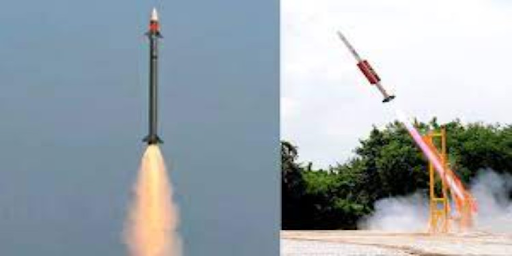24 Aug DRDO tested indigenous missile VL- SRSAM
DRDO Tested Indigenous Missile VL- SRSAM
Prelims: About VL- SRSAM, DRDO
Mains: capabilities of VL- SRSAM
GS Paper 3
Why is it in the news?

Chandipur off the coast of Odisha
The Defence Research and Development Organisation (DRDO) and the Indian Navy on Tuesday successfully flight-tested the indigenously developed Vertical Launch Short Range Surface-to-Air Missile (VL-SRSAM) from the Integrated Test Range (ITR) at Chandipur off the coast of Odisha.
About VL- SRSAM
- VL-SRSAM stands for Vertical Launch – Short Range Surface to Air Missile.
- It is a quick-reaction surface-to-air missile developed by Defence Research and Development Organisation (DRDO)
(A surface-to-air missile (SAM), also known as a ground-to-air missile (GTAM) or surface-to-air guided weapon (SAGW), is a missile designed to be launched from the ground to destroy aircraft or other missiles.)
- It has been designed and developed jointly by three facilities of the Defence Research and Development Organisation for the deployment of Indian Naval warships.
- It has been designed in a way to neutralise various aerial threats at close ranges including sea-skimming targets.
(Sea skimming is a technique many anti-ship missiles and some fighter or strike aircraft used to avoid radar and infrared detection.)

VL- SRSAM
Design of VL-SRSAM
The design of VL-SRSAM is based on the Astra missile, which is a Beyond Visual Range Air to Air missile
- ( Astra (“weapon”) is India’s first air-to-air all-weather beyond-visual-range active radar homing air-to-air missile, developed by the Defence Research and Development Organisation.)
- (A Beyond-Visual-Range missile (BVR) is an air-to-air capable of engaging at ranges of 20 nautical miles or beyond.)
VL-SRSAM is designed in such a way that it will be able to strike high-speed airborne targets at the range of 40 to 50 km and an altitude of around 15 km.
What are the features of VL-SRSAM?
- Cruciform wings: they are four small wings arranged like a cross on four sides and give the projective a stable aerodynamic posture.
- Thrust Vectoring: thrust vectoring is an ability to change the direction of the thrust from its engine to control the angular velocity and the attitude of the missile, an official said. (Thrust is the force that moves an aircraft through the air.)
- It is a canisters system, which means it is stored and operated from specially designed compartments.
- The canister controls the environment inside, thus making its transport and storage easier and improving the shelf life of weapons.
Significance
This favourable result will further intensify the defence capability of Indian Naval Ships against aerial threats.
Defence Mechanism:
Chaffs (originally called Window):
- It is a radar countermeasure in which aircraft or other targets spread a cloud of small, thin pieces of aluminium, metallized glass fibre or plastic, which either appears as a cluster of primary targets on radar screens or swamps the screen with multiple returns, to confuse and distract, developed in the 2nd world war
- Missiles to counter Anti-Ship missiles:
- These systems have to have a swift detection mechanism and quick response to warships.
What is DRDO?
- DRDO is the R&D wing of the Ministry of Defence, under the government of India with a perception to empower India with cutting-edge defence technologies and a mission to achieve self-reliance in critical defence technologies and systems, while equipping our armed forces with state-of-the-art weapon systems and equipment by requirements laid down by the three Services.
- The tagline of DRDO says “Balasya Mulam Vigyanam” which says the source of strength is science-drives the nation in peace and war. DRDO has a firm determination to make the country strong and self-reliant in terms of science and technology, especially in the field of military technologies.
- DRDO was formed in 1958 from the amalgamation of the then-already functioning Technical Development Establishment (TDEs) of the Indian Army and the Directorate of Technical Development & Production (DTDP) with the Defence Science Organisation (DSO). DRDO was then a small organisation with 10 establishments or laboratories. Over the years, it has grown multi-directionally in terms of the variety of subject disciplines, number of laboratories, achievements and stature.
- Today the headquarter of DRDO is in New Delhi, with a network of more than 50 laboratories which are deeply engaged in developing defence technologies covering various disciplines, like aeronautics, armaments, electronics, combat vehicles, engineering systems, instrumentation, missiles, advanced computing and simulation, unique materials, naval systems, life sciences, training, information systems and agriculture.
Source:
Daily Current Affairs for UPSC
Current Affairs provides a broad range of knowledge of the national and international world. Get the best daily current affairs for the UPSC examination free of cost. Also, From Today read weekly and monthly current affairs for IAS exam preparation. The topic described above is based on Science and technology.




No Comments